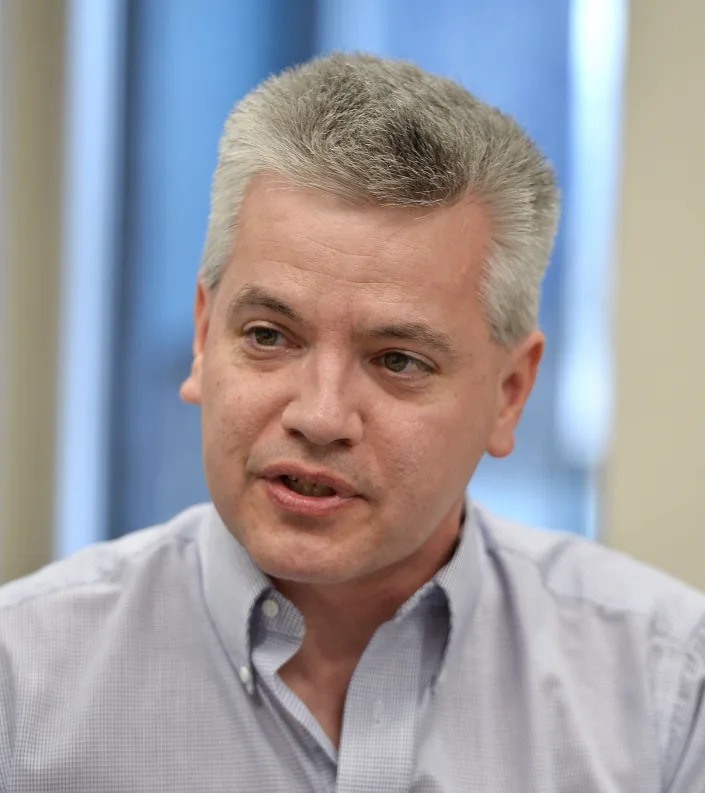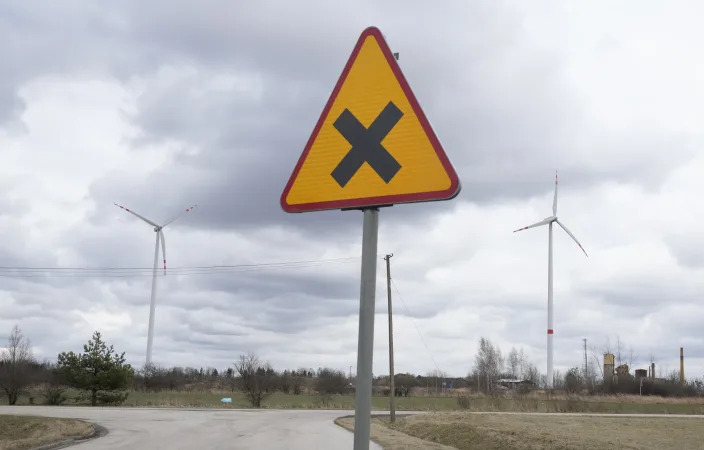The transatlantic network connecting France's 'Freedom Convoy' to Canada




Mon, February 21, 2022
By Layli Foroudi
PARIS (Reuters) - Canadian Alexis Cossette-Trudel, who is suspended from Facebook and Twitter for promoting the QAnon conspiracy theory, had a message he wanted to send from Canada to France.
The "Freedom convoy" protests against COVID-19 vaccine mandates that were starting to block transport links in Canada were striking a blow for freedom and French people should take note, he said in Quebec-accented French.
"The freedom convoy is a festive and exemplary movement," Cossette-Trudel said in a videocast on France Soir, a COVID-sceptic French online media outlet on Feb. 7.
Five days later, a French "Freedom convoy" - with some people waving Canadian flags - defied a police ban to enter the French capital and snarled traffic around the Arc de Triomphe. The police deployed tear gas and made more than 50 arrests.
Reuters has found some of the loudest online voices coordinating France's convoy have direct links with Cossette-Trudel and other Canadians, revealing a network of connections between "anti-vaxx" and right-wing groups in the two countries.
To be sure, the Freedom Convoy in France sprang mainly out of homegrown movements, including the "Yellow Vests" whose protests began in 2018, and the people identified in public as its leaders had no direct ties to their peers in Canada.
But the connections identified by Reuters between French and Canadian anti-vaxxers helped to translate the messages and protest tactics circulating among North American anti-vaxxers for French audiences.
It is a connection that, according to some researchers, could move the needle in April's French presidential election, when anti-vaxxers are likely to be active.
Canadian YouTubers and bloggers, especially those from French-speaking Quebec, are natural intermediaries between North America and France, said Benjamin Tainturier, a researcher with MédiaLab at Sciences Po university in Paris.
"They have French channels [where] they say 'Look what is happening in the U.S.', because they are close to the territory, they speak English as a second mother tongue and they know the Youtuber eco-system."
Cossett-Trudel told Reuters half of his viewership comes from France.
He operates in large part via Radio Quebec, a Francophone platform whose main editorial priority is opposing COVID-19 related restrictions and the vaccine, which he sees as part of "a power grab by the establishment".
Suspended from mainstream social media, he now broadcasts via other platforms such as VKontakte, Odyssee, and Gettr favoured by people like Cossette-Trudel who have been removed from YouTube. Across the three platforms he has a total of more than 100,000 followers.
"LOVE FROM FRANCE"
Historic ties between the two countries led some French people to donate to the Canadian trucker cause.
One fundraiser on the Christian platform GiveSendGo received $8,501 from 130 French people between Feb. 5 and Feb. 10, according to Distributed Denial of Secrets, a website that handles leaked data and said it received hacked donor data.
One donor wrote: "Much love from France, and sorry we sent you the Trudeau family centuries ago." Canadian Prime Minister Justin Trudeau invoked rarely used emergency powers to end the protesters' three-week occupation of Ottawa over the weekend.
Cossette-Trudel says he speaks regularly with Richard Boutry, one of the organisers of the French convoy whom he described as "a friend".
Boutry, a Christian who believes that those in government are "disciples of satan", has appeared on Radio Quebec and has hosted Cossette-Trudel on his own alternative media outlet, La Minute de Ricardo.
Cossette-Trudel has participated in events organised by a Canadian non-profit called the Foundation for the Defence of the Rights and Freedoms of the People (FDDLP).
French anti-vaxx rising stars sit on its board of experts: anaesthetist Louis Fouché and geneticist Alexandra Henrion-Caude, as well as infectious disease professor Christian Peronne and epidemiologist Laurent Toubiana.
The foundation has raised C$1.2 million and the second biggest outlay after lawyer fees is payment to its nine experts, said FDDLP president Stephane Blaise.
Of the four French experts, some are paid and some volunteer, he said, without giving details. Henrion-Caude denied receiving any money and said she had not financed any campaigns. The other experts did not respond when contacted for comment by Reuters.
"A lot of Europeans follow us," said Blaise. "It is a beautiful collaboration."
Analysis of social media activity around the last French presidential election, in 2017, showed that North American and French online activists coordinated on the forum popular with the far-right, 4chan, to swing votes in favour of far-right challenger Marine Le Pen.
In the run-up to the French "Freedom convoy," Twitter accounts calling for or interacting with the protest were mainly connected to anti-vaxxer presidential candidate Florian Phillipot, followed by far-right presidential contender Eric Zemmour, according to data analysis by France's National Centre for Scientific Research (CNRS).
CNRS research director David Chavalarias said the mobilisation - online and off - was a warm-up for the election. "It's going to become more important and more coordinated," he said.
(Reporting by Layli Foroudi; Additional reporting by Allison Lampert in Montreal and Anna Mehler Paperny in Toronto; Writing by Christian Lowe; Editing by Alex Richardson)
Canada truckers say protest is start of bigger movement: ‘I don’t believe this is the end’
Via AP news wire
Sun, February 20, 2022
The streets around the Canadian Parliament are quiet now. The Ottawa protesters who vowed never to give up are largely gone, chased away by police in riot gear. The relentless blare of truckers' horns has gone silent.
But the trucker protest, which grew until it closed a handful of Canada-US border posts and shut down key parts of the capital city for weeks, could echo for years in Canadian politics and perhaps south of the border.
The protest, which was first aimed at a Covid-19 vaccine mandate for cross-border truckers but also encompassed fury over the range of Covid-19 restrictions and hatred of Prime Minister Justin Trudeau, reflected the spread of disinformation in Canada and simmering populist and right-wing anger.
“I think we've started something here,” said Mark Suitor, a 33-year-old protester from Hamilton, Ontario, speaking as police retook control of the streets around Parliament. Protesters had essentially occupied those streets for more than three weeks, embarrassing Trudeau and energising Canada's far right. Suitor believes the protests will divide the country, something he welcomes.
“This is going to be a very big division in our country,” he said. “I don't believe this is the end.”
While most analysts doubt the protests will mark a historic watershed in Canadian politics, it has shaken both of Canada's two major parties.
“The protest has given both the Liberals and the Conservatives a black eye,” said Nelson Wiseman, a political science professor at the University of Toronto. Trudeau's Liberals look bad for allowing protesters to foments weeks of chaos in the capital city, he said, while the Conservatives look bad for championing protesters, many of them from the farthest fringes of the right.
The conservatives “have to be careful not to alienate more moderate voters, who are generally not sympathetic to the protesters or right-wing populism more generally,” said Daniel Beland, a political science professor at McGill University in Montreal.
The self-styled Freedom Convoy shook Canada's reputation for civility, inspired convoys in France, New Zealand and the Netherlands and interrupted trade, causing economic damage on both sides of the border. Hundreds of trucks eventually occupied the streets around Parliament, a display that was part protest and part carnival.
Authorities moved quickly to reopen the border posts, but police in Ottawa did little but issue warnings until the past couple days, even as hundreds and sometimes thousands of protesters clogged the streets of the city and besieged Parliament Hill.
Truckers ignored warnings that they were risking arrest and could have their rigs seized and bank accounts frozen under the new emergency powers invoked by Trudeau. The truckers, parked on the streets in and around Parliament, blared their horns in defiance of a court injunction against honking, issued after residents said the constant noise was making the neighbourhood unlivable.
“It's high time that these illegal and dangerous activities stop,” Trudeau declared in Parliament a few days ago, speaking just a few hundred meters from the protests.
On Friday, authorities launched the largest police operation in Canadian history, arresting a string of Ottawa protesters and increasing that pressure on Saturday until the streets in front of Parliament were clear. Eventually, police arrested at least 191 people and towed away 79 vehicles. Many protesters retreated as the pressure increased.
The Ottawa protests — the movement's last major stronghold — appeared to be largely over by Sunday. Fencing and police checkpoints remained.
“The number of unlawful protesters has dramatically declined in the last 24 hours,” Ottawa interim Police Chief Steve Bell said.
Authorities also said 206 bank accounts had been frozen under the power granted by federal emergencies act.
Public Safety Minister Marco Mendicino said progress has been made but the end of the blockades might not be over. He said that targeted measures in the emergencies act allowed police to designate a wide swath of Ottawa's downtown core to become a no-go zone and that tool alone has been extremely effective.
“For the first time in three weeks the streets are calm, they are quiet and they are clear. That all followed the invocation of the emergencies act,” Mendicino said in an interview with The Associated Press. “We will not use it for a single minute longer than we have to.”
Mendicino said the financial accounts of those who refused to leave will remain frozen while the act is in force but added that it is up to police to decide whose accounts get frozen. The powers are already in effect but Parliament is expected to ratify the action Monday.
As it did in the United States, Covid-19 quickly became a political issue in Canada.
Coronavirus health restrictions became a political cudgel for Canada's far right, which accused Trudeau of authoritarianism. But while the restrictions clearly benefitted the far-right People's Party of Canada, things are more complicated in the Conservative Party.
Only recently have some Conservative leaders fully embraced the pushback against vaccine mandates and coronavirus restrictions.
Even so, the protests may open the door to the sort of populism that former President Donald Trump used to vault himself into the White House.
Pierre Poilievre, who is running to become the next leader of the Conservative party, has cheered on the protesters, gambling that voters will back him. But it remains unclear whether that will get him to the top of the party, or whether it would help or hurt him if there is a showdown between him and Trudeau or the next Liberal party leader.
“Poilievre is clearly playing by the populist playbook right now,” said Beland. “If he becomes Conservative leader, the party might effectively shift towards Trump-style populism. However, it's unclear whether enough Canadians support this vision to make it appealing beyond the party's base.”
The protests have been cheered on in the US by Fox News personalities and conservatives like Trump. Millions of dollars in donations have flowed across the border to the protesters.
About 44 percent of the nearly $10 million in contributions to support the protesters originated from US donors, according to an Associated Press analysis of leaked donor files. Prominent Republican politicians have praised the protesters.
But experts say the US support of the Canadian protesters is really aimed at energising conservative politics in the US, where midterm elections are looming.
Meanwhile, though the situation in Ottawa appeared to be ending, there were new signs the protests had not died out entirely.
The Canadian border agency warned late Saturday afternoon that operations at a key truck crossing from western Canada into the United States had been slowed by protesters, advising travellers to find a different route.


















